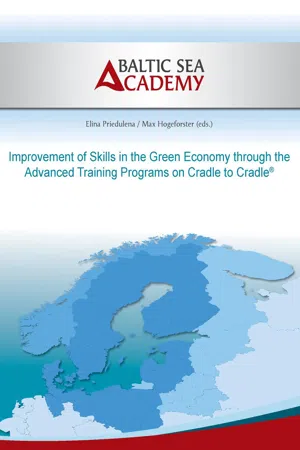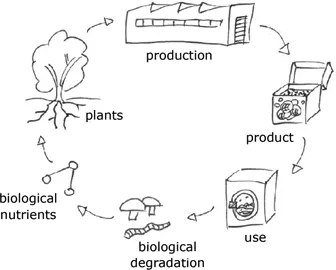![]()
1. Introduction
Energy efficiency, climate and biodiversity protection belong to the EU top priorities and are likewise of considerable and growing importance of the economy in the member states1. In order to meet the challenges of growing landfills, scarcity of resources, air pollution, to name a few of them, new ways of thinking and of economic activity are essential. This is exactly what the Cradle to Cradle® (C2C) concept is: products flow in infinite material life cycles thus being economically successful, conducive to the environment and healthy for consumers without producing any kind of waste. Besides, the C2C is not a brandnew concept that has been popped up for a short moment like a fashionable product that is needed by nobody shortly afterwards. Cradle to Cradle® concept, born as vision by Prof. Dr. Michael Braungart and William McDonough in 1990ies, has become real, and now it is well known on the world market: more than 1.500 products have been developed according to the C2C principles and some regions even switch processual on C2C.
The way of production "from the cradle to cradle" is directly counterposed to the prevailing production model "cradle to grave", where the material cycles are set up regardless of conservation of resources or environmental protection. So far, though, there lacks targeting of C2C concept in SMEs in Europe while increasing energy efficiency and environmental protection is of growing importance in SMEs. Moreover, SMEs with C2C are more future oriented, capture new market segments and create new jobs to reduce their costs and make a vital contribution to tackling the energy and environmental challenges in the long term.
Despite the advantages the Cradle to Cradle approach it has been used only in big companies and is hardly known in SMEs.
Given this, in 2014 the EU co-funded project “Improvement of skills in the green economy through an advanced training program Cradle to Cradle” (C2C for SMEs) was launched. For the past two years the lead of the project has been taken by the Hanse Parlament being an umbrella organization of 50 chambers of commerce, crafts and industry from 13 Baltic Sea Region countries. In 2010 Hanse Parlament established an association Baltic Sea Academy of currently 17 member universities from 9 countries. Together they focus on promotion of innovation and qualification for SMEs. Those 50 chambers and 17 universities are important associated partners and disseminate the project results on a wide basis.
The core partner of the project - the Environmental Protection Encouragement Agency (EPEA), was founded by Prof. Dr. Michael Braungart almost 30 years ago. EPEA brings the expertise of C2C and development and carrying out of further trainings in this field.
Further project partners are the Chamber of Crafts in Schwerin with its Training and Technology Center, the Lower Silesian Chamber of Craft and Small and Medium-sized Businesses in Wroclaw and the Hungarian Association of Craftsmen’s Corporations having close cooperation with SMEs, expertise of their needs and human resources and facilities to train.
Satakunta University of Applied Sciences contributes with excellent Know-How in scientific evaluation and training planning inter alia and last but not least the Regional Fund for Environmental Protection and Water Management in Gdansk makes crucial content-related contributions and supports with founded knowledge of environmental issues in particular.
The overall aim of the project is to sensitize owners and employees in SMEs for the topic Cradle to Cradle and to empower those to use C2C through tailored advanced training.
This is accompanied by the important goal to qualify people in terms of future labor market needs and to provide skills that are of growing importance for the future of companies. Therefore in the project life time advanced training on C2C for SMEs is developed. Participating in the training C2C methodology, products and the way to apply C2C is introduced, receiving knowledge and skills in an interactive, multi-stage process with the possibility to apply C2C methodology during the training in own enterprise. The environmental management in SMEs is particularly addressed, so that environmentally conscious entrepreneurship and entrepreneurial skills are promoted. The developed advanced training is tested in practice in Germany, Poland and Hungary and subsequently transferred to the associated partners that receive constant consultations to enable sustainable implementation of C2C.
Another aim is to qualify employees of universities and chambers on the subject so that well qualified lecturers are constantly available for SMEs as trainers and advisors for individual support.
So this book on the one hand comprises all main project results with materials that can be freely used and on the other hand contributions on the project subject that were prepared according to the speeches made at the final project transfer and dissemination conference in Hamburg from May 18 – 19, 2016.
At this point, sincere thanks go to all project partners for the very committed and good cooperation in the past two years and the experts for the valuable contributions during the conference and in the present publication.
![]()
2. The Cradle to Cradle Design Concept – Remaking the way we make things2
2.1 The Cradle to Cradle Design concept
The Cradle to Cradle Design – An introduction
Cradle to Cradle® (C2C) was developed in the 1990s by Michael Braungart, William McDonough et al., based on research at the Environmental Protection Encouragement Agency in Hamburg, Germany, for designing beneficial economic, social and environmental features into products, processes and systems. Cradle to Cradle® is primarily an entrepreneurial and innovation concept that starts by determining the intended benefits of a product or service instead of focusing on minimizing negative environmental impacts.
To enhance quality and add value for stakeholders, C2C promotes innovation partnerships along the entire chain of a product, including manufacturing, distribution, use, disassembly, recovery and reuse. By characterizing hundreds of products and thousands of materials for their human and environmental health attributes, as well as defining systems to safely and fully cycle materials into new products, C2C has already provided a practical yet inspirational scientific and business model for improving quality.
Extensive books, cover stories and documentary films have been published and broadcasted about C2C since the 1990s. The book Cradle to Cradle is well known and translated into at least a dozen languages.
Cradle to Cradle® can be divided into these categories that make up together the C2C Framework:
- Philosophy e.g., a quality-based innovation platform for benefitting the economy, ecology and social equity.
- Principles that are translated into measurable criteria.
- Application criteria.
Philosophy
The conventional approach of government and industry has been to minimize the environmental impacts of their activities by being “less bad” as products go from “Cradle to Grave”. This approach is often regarded as involving extra costs for stakeholders without many quantifiable benefits, often related to sustainability.
However, the Cradle to Cradle® Design Protocol has taken a fundamentally different approach that generates benefits for stakeholders by going beyond the “grave” and beyond conventional interpretations of “environment”.
Cradle to Cradle® is a design paradigm that focuses on innovation to enhance the quality of products so they are:
- more practical for the user
- healthier for everyone affected by the product
- beneficial for the economy and the environment.
The principles
Quality enhancement is achieved by focusing on three innovation principles:
Waste = Food. Everything is designed to be a nutrient for something else.
Use Current Solar Income. Energy that can be renewed as it is used.
Celebrate Diversity. Species, Cultural, and Innovation Diversity
Biosphere and Technosphere
To apply those principles, Cradle to Cradle® focuses on optimizing the intended use of a product. It distinguishes between two main intended pathways that products follow: consumption pathways where products are designed to safely enter biological systems and service pathways where products safely enter technical systems to be part of new future product generations.
Products for consumption are designed in a way that degradation by-products generated during their use (e.g. abrasion or dilution in air, water or soil) can support the biological systems they enter. Biological resources can be renewed through agriculture or reforestation leading to next generations of products. Examples of consumption products are: biodegradable textiles, cosmetics, cleaning agents or vehicle brake pads that wear out.
Products for service are designed to be chemically stable during use and get dismantled into material resources, known as ´technical nutrients´ after they have fulfilled their function. The ingredients in these renewed technical nutrients are carefully defined so they can serve as resources for the production of next generations of service products. Examples of service products are electronic appliances and cars.
biological cycle
for Products for Consumption
technical cycle
for Products for Service
Figure 1: The technical and biological cycle
The Application Tools and Criteria
The criteria or tools outlined here are intended to enhance and accelerate implementation of the C2C criteria. These tools are sometimes not unique to C2C. It is their integration rather than any individual factor that results in C2C benefits.
Examples of C2C Application Tools and Criteria
- Actively Beneficial Qualities
Material and Products which are defined regarding their ingredients and have an active positive impact on human and environment.
- Defined Product Recycling
Dedicated sorting, disassembly and recycling of high quality and defined materials that are more economic to recover on their own instead of being mixed with other material streams. This also facilitates upcycling to improve materials quality and use.
This describes the use of materials in their pathways from sourcing to manufacturing, use, disposal and reuse, recycling or decomposition.
Many “green” criteria require products to be “durable” to last as long as possible. However, this approach is often counterproductive because when products last longer than they are optimal useful they perpetuate obsolete technologies, resulting in reduced benefits for users and unnecessary loss of revenues of business. The durable approach can also make recovery of materials more difficult for example by making them harder to disable. Because of this, C2C emphasizes designing materials or ingredients according to an intended use period of the product, to promote practical recovery of materials so they can be used in new products.
This occurs when diverse industries develop a pool of defined materials to achieve economy of scale, commercial flexibility and improved quality.


